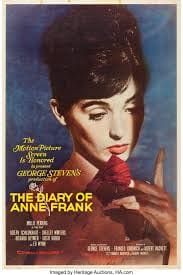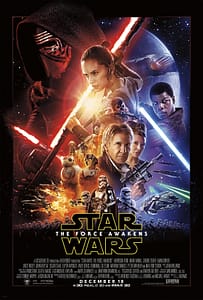MPAA Rating: NR/ Genre: War Drama/ Stars: Millie Perkins, Joseph Schildkraut, Shelley Winters, Richard Beymer, Gusti Huber, Lou Jacobi, Diane Baker, Douglas Spencer, Dodie “Dody” Heath, Ed Wynn/ Runtime: 180 minutes
I think it is easy to say beyond a doubt in my mind movie goer that The Diary of Anne Frank will always be seen as the finest retelling from a film perspective of one of the most potent yet also heartwrenching and sob-inducing tales to come out of the annals of the Second World War that involved a pair of Jewish families struggling to stay hidden following the Nazis occupying the country of Amsterdam as told in the diary of one of the families’ youngest daughter. Indeed this phenomenal yet all true tale of struggling to survive against all odds during some of the most terrifying years in human history was showcased quite phenomenally in this bonafide classic. Indeed this is a film that is meant to engage both your heart and your mind in equal measure. Yet, despite being labeled as a War Drama, this is not your typical entry in that storied genre. This is because this film doesn’t really deal with the conflict as seen through the eyes of the soldiers fighting it, but rather from the point of view of those hiding away so they don’t become casualties of one side’s complete and utter annihilation campaign to say nothing of showcasing the potent pathos, the horror, and the day to day that this pair of families found they were to endure if only due to the innate power of the human spirit. Yet from a technical point of view this film is also a rousing success since it is able to completely immerse you in its enclosed and borderline claustrophobic shooting locales as well as how limited the camera moves thus making you feel like you are in the hideout with these two families. Indeed this is a film which, more often than not, makes you feel like you are watching a theater production with only the every now and then inserted cinematic touch or dramatic touch to help distinguish it from the source material and the original play, but it is how overwhelmingly loyal it is to that source material and deep respect for these real-life people and the nightmarish situation that they found themselves tragically involved in more than anything else which has helped make this film a truly iconic entry in the world of cinema even though it has been some 5-plus decades since this film first came out all the way back in 1959.
The plot is as follows: In the middle of all the chaos, anarchy, and peril that was World War II, a pair of Jewish families consisting of the Franks who are comprised of patriarch Otto, matriarch Edith, and their pair of girls by the names of Anne and Margot and the Van Daans who are comprised of patriarch Hans, matriarch Petronella, and their son Peter find themselves all going into hiding together in a tiny loft in Amsterdam in an attempt to hide from the encroaching Nazis whose desire is to have every single Jew in existence put in a concentration camp and then eventually killed simply because of their heritage. Thus this is a film that tells the riveting tale of these families’ two-years of evading their pursuers whilst also showcasing the difficulties they had to go through due to having to live their lives by a stringent collection of rules that really did a number on what they could do on a daily basis whilst also keeping them from leaving the loft and also transforming every step they took and every whisper they uttered into something that had the potential to be disastrous for them all. However even as they still find themselves struggling to survive in this world that has taken everything from them save for their unyielding spirit, our pair of families still find themselves able to witness the highs and lows that life has to offer all of us even though the risk of detection to say nothing of the seemingly nonstop conflict are always right there on the horizon when they wake up and amongst the stars when they drift off to sleep…
Now the vast majority of why The Diary of Anne Frank is as much of the riveting and quite emotional triumph it turns out to be is due to how, in virtually every frame that we are given, the movie is able to seamlessly ensnare the whole breadth of life in this vital hideout. Indeed this film does a wonderful job of showcasing both the day to day routine that this pair of families had whilst also both highlighting moments of genuine happiness and excruciating unease and also keeping the quite palpable fear and terror these families most assuredly were feeling present at all times. Indeed this living nightmare that these two families found themselves unwilling participants in has always been one that has been hard to fathom even after all this time because none of us could ever see ourselves in a situation where making a single noise could result in our death or getting a cake was like being given a bar of gold. Yet even in scenes where nothing particularly crucial is going on, this film will still manage to prove itself quite riveting to you movie goer due to how extraordinarily well it manages to chillingly ensnare both the day to day of “normal life” as well as the overwhelming amount of terror and unease that permeated these families’, to say nothing of countless others’, lives in Nazi-overwhelmed Europe during World War 2.
Indeed, it is within this movie’s recreating of the terrible stress and omnipresent feeling of peril which follows every word spoken, every step moved, or every time a character looking out the window which could end either with everyone still safe in their hideout for another day or being turned over to the Nazis to be sent to the camps that is the primary reason this film is so riveting. Indeed filled with quite a few moments which manage to be silent yet perilous and thought-provoking at the same time, this film manages to showcase with a terrifying degree of realism just how perilous something as simple as leaving something in the microwave for a second too long or a dog pouncing on your lap would have been for these people. Indeed moments in this vein when they occur in this manage to be more suspenseful and terrifying than most that modern-day “horror” films manage to showcase in their entirety, but this is because this is a film that ensnares real-world terror with an unflinching realism and shows us that even the happiest of moments for this family still manage to bring to their doorstep both remembrances of the conflict outside their door as well as the overwhelming danger that is all around them. Indeed for the Franks and Van Daans, it really does feel like not only has survival become very similar to a stealth exercise, but that the way they are living could be seen as almost inhuman. Not because of how tight-knit they are or their lack of privacy or for what they may or may not have, but rather due to the tragic limitations that they have placed on themselves in order to simply make it one more day without anyone the wiser.
To that end, and from a technical perspective it should be pointed out that this film manages to completely blows away any sense of conventionality and actually is a terrific representation of film that is both intriguing and quite riveting regardless of the fact that this film has only one main shooting location, its narrative is moved forward courtesy of dialogue, and that it clocks in at, including credits, three hours long. Indeed this is a film which is a fine representative of the classes of both terrific filmmaking and the style known simply as “less is more”. Indeed propelled forward by the potency contained in both the narrative and through its cast’s phenomenal work, with particular regard towards Joseph Schildkraut as Frank family patriarch Otto, this is one film which is just pure excellence with the bookends set in the war’s aftermath being some of the most difficult for some to sit through because of how they prove to be quite the gut punch in regards to how conflict sometimes turns out. A tragedy that can see cities decimated, hearts torn to shreds, and a simple diary is changed from a personal look back to a powerful analysis of the power of optimism and how unconquerable the human spirit truly can be in the worst conditions possible. Suffice it to say then that this film is able to succeed and be the truly great movie experience that it is because of the fact that the story is always at the heart of everything and because all the technical elements at play are there to aid the narrative rather than take over and override it.
All in all it goes without saying, but The Diary of Anne Frank really truly at the end of the day is one of the most priceless jewels amongst the collection known as classic and iconic cinema. Yet it isn’t because of anything in regards to work done either in front of or behind the camera, but rather because of the truly undeniably potent nature of the narrative it chooses to share with all of us. Indeed as a film that is meant not to be watched, but rather experienced, The Diary of Anne Frank is able to put some distance between itself and its fellow movies as one of the most emotionally moving films that I have ever seen, and the tale it tells is truly one of the best at showcasing not only the human condition laid bare before us, but also of the unflinching strength the human spirit can and does possess when it comes to triumphing over any adversity that stands in its path. On a scale of 1-5 I give The Diary of Anne Frank “59” a solid 5 out of 5.



